Friendly Information Provided
All details and information provided on this page is provided impartially, upon a basis of "in our opinion only"; and whereas we make no warranties (whether expressed or implied) in relation to its accuracy.
Gold Prospecting vs. Gold Mining
In General Terms:
Gold Prospecting is searching for gold deposits which may involve the use of gold panning to confirm that gold is present in test spots.
Gold Mining is both the extraction and removal of gold from it's location, with or without the use of gold panning.
Gold Panning Technique
Gold Panning is a traditional technique of mining placer deposited gold. Placer deposits are an accumulation of variety of materials, including soil or sediments, fine particles of silt and clay and larger particles of sand and gravel, including valuable minerals, such as precious metals and gem stones.
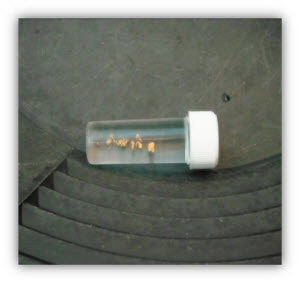
Placer deposits are loose not cemented together into a rock, materials which have been eroded away, and possibly reshaped by water and the elements, and then re-deposited.
There are various different types of placer gold, but for the purpose of this document, we will be concentrating on gold that has moved and has reached streams and river beds.
The process of gold panning is scooping up these materials in to a gold pan with water, and using various agitated techniques to work the heavier materials to the bottom of the pan, whilst the low specific gravity materials are left above, and slowly spilled out of the pan.
The heavier materials left in the bottom of the pan usually consist of, magnetite, ilmenite, hematite whatever gemstones, and metals such as gold.
How Does Gold Panning Work
Gold panning is a simple process where materials with a higher specific gravity sink to the bottom of the sediment, whilst materials with a low specific gravity are allowed to spill out of the pan.
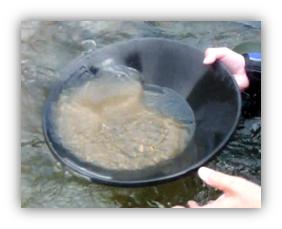 Using a Gold Pan of a comfortable diameter, fill it to no more than three quarters of the way with material, and then top up with water to the top.
Using a Gold Pan of a comfortable diameter, fill it to no more than three quarters of the way with material, and then top up with water to the top.
1. Holding the pan at a slight tilt downwards away from you, agitate the mixture by slightly shaking and swirling the pan left to right, continuing for 30 seconds to a minute or so.
The most important part of this technique is agitating the mixture so that the heavier materials like gold are worked down to the bottom on the pan. If not enough care is taken in this first stage, then the gold can be washed out of the pan in the next stage.
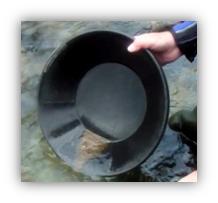
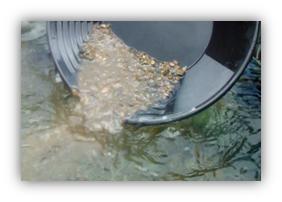 2. Next wash out the lighter materials by holding the pan at a slight tilt downwards away from you, and submerge into water so that all material is just covered. Gently move the pan forwards and backwards washing the lighter marital out of the gold pan. Keep repeating the process from agitating the mixture, until very little material is left. each time slightly increase the angle of the slant. Don't tilt the pan too much.
2. Next wash out the lighter materials by holding the pan at a slight tilt downwards away from you, and submerge into water so that all material is just covered. Gently move the pan forwards and backwards washing the lighter marital out of the gold pan. Keep repeating the process from agitating the mixture, until very little material is left. each time slightly increase the angle of the slant. Don't tilt the pan too much.
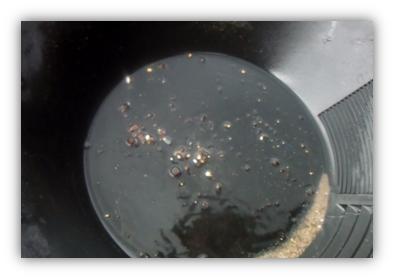
3. Separate the gold from the remaining heavy materials by using a backwash method. With the remaining material covered by an inch of water, holding the pan as before, and agitate the materials all together, continue for 30 seconds to a minute. Carefully empty out most of the waters without disturbing the consolidated material, so that it remains covered by just a little water.
Then tilt the pan slightly downwards towards you, so that the water slides down carrying some material with it. Gently tilt the pan back downwards away from you, to let the water return to the consolidated material.
Continue this to remove the material leaving the gold behind. Sometimes swirling the water gently around the pan left to right helps this separation process.
Use a Snuffer Bottle to suck up the gold from the Gold Pan, then remove the straw from the Snuffer Bottle. Place the end of the Snuffer Bottle into a Vial, and squeeze so that it's contents are transfered into the Vial. Remember to re-insert the straw back into the Snuffer Bottle as it was before.
These are some geneal tips, to help getting started. You will find your own techniques with experiance, trial, error and success.
Where to Look for Possible Gold Deposits
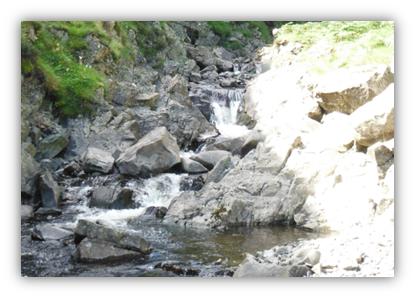
Most recreational panning for gold is done in small burns, streams, creeks and rivers.
As a general rule, gold can be found on the insides of the stream bends, behind obstacles like rocks and boulders, and wedged in traps on the bedrock. Gold is about 19 times heavier than water.
Sometimes it is possible to work out locations where gold may have travelled, become trapped or been dropped, by examining the stream route, locating bedrock at the sides of the streams and following it down into the stream, and by identifying where there are constrictions in the stream width and then it fans out.
Working In The Stream Searching For Gold
Start by raking away about a square meter of material down to about 6 inches deep (depending on how far down to bedrock), then by using gravel pump, suck up the material from the stream bed and pump out directly into a sluice or into a classifier over a bucket.
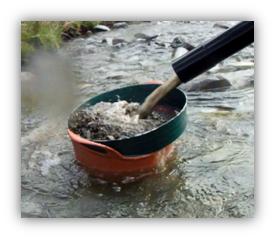
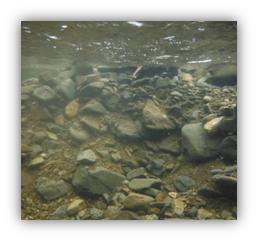
If pumping directly into a sluice, ensure the sluice is built for this purpose. A classifier is a sieve which has various mesh sizes used to reduce the material down to a size which can be then feed into the sluice. A popular mesh size for seperating matreial to feed into a traditional sluice is 1/2 inch.
Continue, by moving larger rocks out of the way sucking up material, until you get down to the bedrock. Suck up all the very small debris lying on the bedrock surface with a Bedrock Vacuum. This small debris can contain fine gold which is not easily seen.
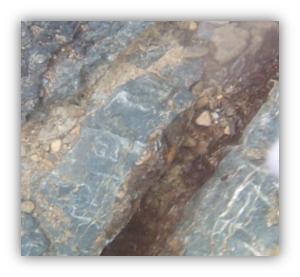 Using an Underwater Viewing Scope, examine the bedrock to expose traps where gold may be trapped. Traps can be small cracks in the bedrock, holes or ridges which may be covered over by hard compacted clay and other debris. Use a Crack & Crevice Scraper to dislodge this clay and debris build ups.
Using an Underwater Viewing Scope, examine the bedrock to expose traps where gold may be trapped. Traps can be small cracks in the bedrock, holes or ridges which may be covered over by hard compacted clay and other debris. Use a Crack & Crevice Scraper to dislodge this clay and debris build ups.
Removing some fine material from these cracks can prove difficult particularly if they are a few inches deep or more. A great way of getting any trapped gold flakes from these locations can be achieved by the use of a Sniping Hand Pump.
 Browse
Site
Browse
Site
 © Gold Panning Equipment 2025
© Gold Panning Equipment 2025 Search
Site
Search
Site
 © Gold Panning Equipment 2025
© Gold Panning Equipment 2025 Your Account
Sign in / Register
Your Account
Sign in / Register
 © Gold Panning Equipment 2025
© Gold Panning Equipment 2025 Check Out
Shopping Cart
Check Out
Shopping Cart
 © Gold Panning Equipment 2025
© Gold Panning Equipment 2025

 Using a Gold Pan of a comfortable diameter, fill it to no more than three quarters of the way with material, and then top up with water to the top.
Using a Gold Pan of a comfortable diameter, fill it to no more than three quarters of the way with material, and then top up with water to the top.

 2. Next wash out the lighter materials by holding the pan at a slight tilt downwards away from you, and submerge into water so that all material is just covered. Gently move the pan forwards and backwards washing the lighter marital out of the gold pan. Keep repeating the process from agitating the mixture, until very little material is left. each time slightly increase the angle of the slant. Don't tilt the pan too much.
2. Next wash out the lighter materials by holding the pan at a slight tilt downwards away from you, and submerge into water so that all material is just covered. Gently move the pan forwards and backwards washing the lighter marital out of the gold pan. Keep repeating the process from agitating the mixture, until very little material is left. each time slightly increase the angle of the slant. Don't tilt the pan too much.




 Using an Underwater Viewing Scope, examine the bedrock to expose traps where gold may be trapped. Traps can be small cracks in the bedrock, holes or ridges which may be covered over by hard compacted clay and other debris. Use a Crack & Crevice Scraper to dislodge this clay and debris build ups.
Using an Underwater Viewing Scope, examine the bedrock to expose traps where gold may be trapped. Traps can be small cracks in the bedrock, holes or ridges which may be covered over by hard compacted clay and other debris. Use a Crack & Crevice Scraper to dislodge this clay and debris build ups.